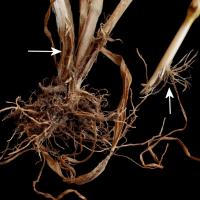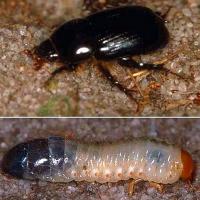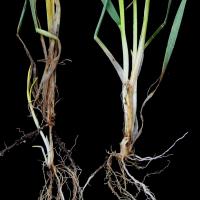Diagnosing African black beetle
A pest of cereals and perennial grasses, adult and larval African black beetles can cause economic damage to wheat and barley crops during autumn and winter on the south coast of Western Australia (WA) especially in crops growing close to, or following kikuyu pastures.
What to look for
- In winter, larvae feed on underground plant parts, causing them to wither and die, leading to bare areas.
- Crops after pasture are most likely to be damaged.
- In spring adult beetles chew the stems below ground level and kill individual tillers. The emerging shoot may die first.
- New shoots emerging below chewed parts.
Plant
- Glossy black, slow moving beetle 12-14 millimetres (mm) long. These beetles are strong fliers even though they feed under the soil surface on plant roots.
Insect Adult
- Typical C-shaped cockchafer with 3 pairs of legs on the thorax.
- Larvae are creamy-white except for the brown head and the hind segments, which appear dark from the gut showing through the body wall.
Insect Larvae
What else could it be
| Condition | Similarities | Differences |
|---|---|---|
| Diagnosing sandgropers | Seedlings with chewed roots | Sandgroper damage is usually localised to the West Midlands |
| Diagnosing cockchafers | Seedlings with chewed roots and 'C' shaped larvae present | African black beetle larvae have horizontal opening on the tip of the abdomen. Cockchafers have a vertical opening. Adult African black beetle are usually present in the paddock with larvae |
Where did it come from?
- Adult beetles fly into crop paddocks in late summer from nearby breeding areas dominated by perennial grass.
Management strategies

Rotation
- Rotation with pure legume crop or pasture may reduce beetle numbers, but is usually not feasible.
- Difficult to control beetles with chemicals as adults always underground.
How can it be monitored?
- Check cereal crops in southern areas for damage symptoms and the presence of adult beetles. Most damage is caused by the adults during autumn and early winter, as larvae are present only during late spring to mid-summer.
Page last updated: Friday, 17 April 2015 - 2:12pm





